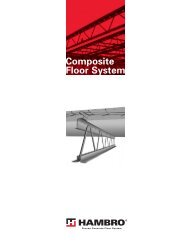You also want an ePaper? Increase the reach of your titles
YUMPU automatically turns print PDFs into web optimized ePapers that Google loves.
DESIGN PRINCIPLES AND CALCULATIONS - INTERFACE SHEAR<br />
For a uniformly loaded joist, the average interface shear s, at<br />
ultimate load when calculated by ultimate strength principles,<br />
would be:<br />
s = 2T u<br />
L<br />
........................................................ (13)<br />
and would represent the average shear force, per unit length,<br />
between the points of zero and maximum moment. Some<br />
modification to this formula would occur when the strain neutral<br />
axis at failure would be located within the section. As this<br />
modification is slight and would only occur with bottom chord<br />
areas greater that 1.84 sq. in., it is neglected.<br />
Compare the elastic and ultimate approaches:<br />
Since M u = T u d u equation (13) can be rewritten:<br />
S = 2M u<br />
d u L<br />
Also, for a uniformly distributed load,<br />
........................................................ (14)<br />
M ........................................................ (15)<br />
u = VuL 4<br />
Subscipts u, are added to equation (12) to represent the<br />
arbitrary “q” force at failure:<br />
q ........................................................ (16)<br />
u = VuQ Ic Combining (14) and (16) results in:<br />
qu = ............................................ (17)<br />
DuL x VuQ s 2Mu Ic and, substituting (15) into equation (17)<br />
qu = 2QDu s Ic ..................................................... (18)<br />
The value I c /Qd u has been calculated for the various <strong>Hambro</strong><br />
composite joist sizes, is a constant, and = 1.1. Substituting this<br />
in (18),<br />
qu = 1.82<br />
s<br />
This verifies that q and s are closely related and that the<br />
interface shear force does, in fact, vary from a maximum at<br />
zero moment (maximum vertical shear) to a minimum at<br />
maximum moment (zero vertical shear). The more recent full<br />
scale testings programs have consistently established a failure<br />
value for qu = 1,300 lb./in. and using a safety factor of 1.85,<br />
the safe limiting interface shear, q = 700 lb./in. This is sometimes<br />
converted to “bond stress” u = q / embedded<br />
perimeter = q / 7.0. Hence, the safe limiting “bond stress”<br />
u = 700 / 7 = 100 psi.<br />
As a further safety factor, the bond stresses are usually limited<br />
to a value less than 90 psi.<br />
11



